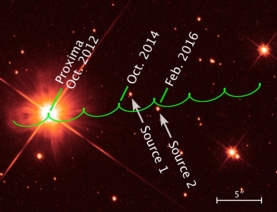







| BOOKS | F. A. Q. | ARTICLES | TALKS | ABOUT KEN | DONATE | BEYOND OUR KEN |
|---|
By Ken Croswell
Published on New Scientist (November 29, 2016)

Proxima Centauri is the bright star at left; the green curve shows its apparent trek across our sky. Credit: Hubble Space Telescope. Kailash Sahu et al. (2014) and NASA.
They’re a happy family after all. The three closest stars to the solar system all revolve around one another, astronomers say, resolving a century-long debate.
The nearest of the three, Proxima Centauri, is a red dwarf 4.24 light-years from us. It made a splash in August when astronomers reported that it hosts an Earth-mass planet where temperatures might be right for liquid water.
Just beyond that, 4.37 light-years away, shine two bright stars named Alpha Centauri A and B. They orbit each other every 80 years and glow yellow and orange respectively. To the naked eye, they blend together to appear as the third brightest star in the night sky.
In contrast, Proxima Centauri is too dim to see without a telescope, so it was only discovered in 1915.
Ever since, astronomers have thought Proxima Centauri might revolve around Alpha Centauri A and B – but couldn’t prove it.
If Proxima is bound to them, then it must move through space with nearly the same velocity. Otherwise, the little star would escape their gravitational grasp. Proxima and the Alpha Centauri pair are 13,000 times farther apart than the Sun is from the Earth.
Precise velocities
In recent years, planet hunters have been able to measure extremely precise velocities as they hunt for the tiny shifts a small planet, like the one orbiting Proxima, induces in its star, tugging it towards and away from us.
“That’s the reason why it is possible now to be sure that there is a gravitational link” between Proxima and Alpha Centauri, says Pierre Kervella at the Paris Observatory in France.
Moreover, the work reveals Proxima’s orbit for the first time. The star revolves once every 550,000 years on an elliptical path. At its closest approach, Proxima is 4300 Sun-Earth distances from its partners; at its farthest, the star is 13,000 Sun-Earth distances out, which is where it is now.
To determine precise velocities, Kervella and his colleagues had to worry about subtle effects that most observers neglect. For example, as photons escape a star’s gravity, they lose energy, slightly shifting their wavelengths to a redder colour. And the stars’ upwelling surfaces, on the other hand, make the photons shift slightly blue.
After correcting for these effects, the scientists conclude that Proxima Centauri’s velocity through space differs from that of its bright partners by just 270 metres per second – half the speed it would need to escape their gravitational grasp. The three stars are definitely an orbital trio.
Ken Croswell earned his Ph.D. in astronomy from Harvard University and is the author of The Alchemy of the Heavens and The Lives of Stars.
"An engaging account of the continuing discovery of our Galaxy...wonderful." --Owen Gingerich, The New York Times Book Review. See all reviews of The Alchemy of the Heavens here.
"A stellar picture of what we know or guess about those distant lights."--Kirkus. See all reviews of The Lives of Stars here.
| BOOKS | F. A. Q. | ARTICLES | TALKS | ABOUT KEN | DONATE | BEYOND OUR KEN |
|---|